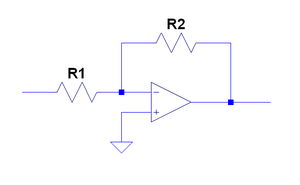Chapter 1: Difference between revisions
Jump to navigation
Jump to search
No edit summary |
|||
| Line 58: | Line 58: | ||
*The common-mode rejection ratio (CMRR) is the ratio of the magnitude of the differential gain to the magnitude of the common-mode gain |
*The common-mode rejection ratio (CMRR) is the ratio of the magnitude of the differential gain to the magnitude of the common-mode gain |
||
**In decibels <math> CMRR = 20 \log \frac{| A_d |}{| A_cm|}</math> |
**In decibels <math> CMRR = 20 \log \frac{| A_d |}{| A_cm|}</math> |
||
| ⚫ | |||
| ⚫ | |||
| ⚫ | |||
| ⚫ | |||
| ⚫ | |||
=Bag of Tricks= |
=Bag of Tricks= |
||
| Line 70: | Line 64: | ||
*Inverting amplifier |
*Inverting amplifier |
||
[[Image:Inverting.png|thumb|widthpx|Inverting Amplifier]] |
[[Image:Inverting.png|thumb|widthpx|Inverting Amplifier]] |
||
| ⚫ | |||
| ⚫ | |||
| ⚫ | |||
| ⚫ | |||
| ⚫ | |||
Revision as of 16:00, 8 January 2010
Amplifier Models
- These are purely models, and cannot be replicated in a real world environment. They are meant to explain.
- Trans stands for transfer - from voltage to current or visa versa.
- The inputs and outputs can be either current or voltage. This leads to 4 amplifier models.
- You can use any of these models, though some may be easier to work with (if you are given the Thevenin or Norton equivalent)
| Amplifier type Gain parameter Gain equation |
Voltage input | Current input |
|---|---|---|
| Voltage output | Voltage Open-circuit voltage gain |
Transresistance Open-circuit transresistance gain |
| Current output | Transconductance Short-circuit transconductance gain |
Current Short-circuit current gain |
| Amplifier Type |
Input Impedance |
Output Impedance |
Gain Parameter |
|---|---|---|---|
| Voltage | 0 | ||
| Current | 0 | ||
| Transconductance | |||
| Transresistance | 0 | 0 |
Differential Amplifiers
- Differential amplifiers take two (or more) input sources that produce an output voltage proportional to the difference between the input voltages.
- Instead of expressing the input voltages in terms of and , we can express it in terms of the differential and common-mode input. Why?
- Differential input signal is the difference between the input voltages.
- Common-mode input signal is the average of the input voltages.
- , if is the positive terminal
- , if is the negative terminal
- See Figure 1.44 on page 49 for a good visual reference
- , where is the differential gain and is the common mode gain
- The common-mode rejection ratio (CMRR) is the ratio of the magnitude of the differential gain to the magnitude of the common-mode gain
- In decibels
Bag of Tricks
- Buffer amplifier
- Inverting amplifier
Definitions
- Input Resistance: of an amplifier is the equivalent resistance seen when looking into the input terminals
- Output Resistance: is the Thevenin resistance seen when looking back into the output terminals of an amplifier
- Open-circuit voltage gain: the ratio of output amplitude to input amplitude with the output terminals open circuited
- Short-circuit current gain: the current gain with the output terminals of the amplifier short circuited






















